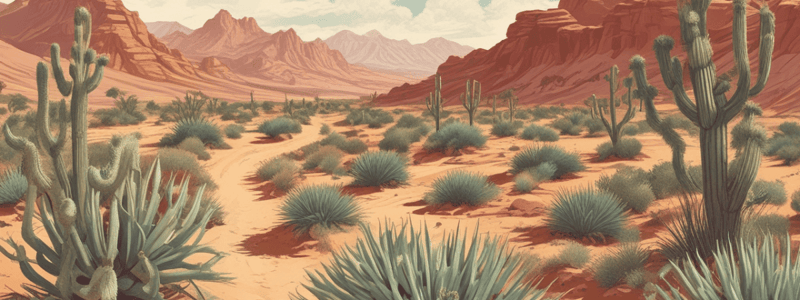Podcast
Questions and Answers
What is a traditional use of Yerba Santa according to the content?
What is a traditional use of Yerba Santa according to the content?
- To control senility for a time (correct)
- To treat illnesses related to the digestive system
- To cure cancer
- To promote weight loss
What is the nature of the illnesses treated by Yerba Santa?
What is the nature of the illnesses treated by Yerba Santa?
- Caused by external agents
- Psychological and emotional
- Acute and infectious
- Deteriorative in nature (correct)
According to Matthew Wood, where does Yerba Santa apply itself?
According to Matthew Wood, where does Yerba Santa apply itself?
- The internal body linings such as the pleural cavity, meninges of the brain, and the synovial fluid linings of the joints (correct)
- The blood and circulatory system
- The skin and outer body linings
- The organs and glands
What is a characteristic of Yerba Santa that the author has discovered?
What is a characteristic of Yerba Santa that the author has discovered?
What is the author's notion about the sense of immovability in Yerba Santa?
What is the author's notion about the sense of immovability in Yerba Santa?
What is the best way to describe the spirit of Yerba Santa?
What is the best way to describe the spirit of Yerba Santa?
When is the best time to collect Yerba Santa in southern California?
When is the best time to collect Yerba Santa in southern California?
What is the condition of the plant when it is gathered?
What is the condition of the plant when it is gathered?
What is a factor that determines the harvest time of Yerba Santa in Arizona?
What is a factor that determines the harvest time of Yerba Santa in Arizona?
What is the botanical name of Yerba Santa?
What is the botanical name of Yerba Santa?
Study Notes
Yerba Santa (Eriodictyon spp.)
- Native to California, Oregon, Nevada, Utah, Arizona, and Baja California.
Energetics and Properties
- Warm and dry.
- Sweet, pungent, and slightly bitter.
- Vital stimulant, tonic, astringent, and relaxant.
- Decongestant, expectorant, mucolytic, anticatarrhal, bronchial dilator, carminative, antiseptic, antispasmodic, antioxidant, astringent, digestive, and disinfectant.
Uses
- Internally: Cough, cold, flu, chest congestion, urinary tract infection, gas, bloating, asthma, bronchitis, catarrh, cystitis, leucorrhea, vaginitis, diarrhea, dysentery, fever, hay fever, sinusitis, hemorrhoids, pharyngitis, laryngitis, pneumonia, pleurisy, rheumatism, sinus congestion, sore throat, smoker's cough, and tuberculosis.
- Externally: Broken bones, bruises, sprains, strains, fever, insect bites, stings, poison oak and ivy rash, eczema, sores, rheumatism, and partial paralysis.
Collecting and Preparation
- Gathered whenever fresh, green, and vibrant.
- In southern California, often in early spring; in northern California, late spring to mid-summer; and in Arizona, from April to November, depending on proper moisture.
Additional Information
- Yerba Santa means "Holy Herb" in Spanish.
- The plant can look brown and withered in early July, but vibrant in early November, depending on moisture.
- Prune fresh, flexible new growth at the end of the branch, gathering no more than 10% of the branches from any one plant.
- Dry the wooly varieties loosely in paper bags, and the resinous species on a screen or cloth in the shade, checking periodically to turn and mix.
- Strip the leaves and use as desired, discarding or using the stem with less effect.
- Yerba Santa can be used in decoction, tincture, fresh or dry, syrup, oxymel, wash, poultice, steam inhalation, douche, pessary, chew, and smudge.
- It is said to hold truth with integrity, anchored within a sense of rootedness, and is the epitome of tai chi, with a sense of neutrality and flexibility.
Studying That Suits You
Use AI to generate personalized quizzes and flashcards to suit your learning preferences.
Related Documents
Description
Learn how to properly prune, gather, and dry desert plants to ensure their health and quality. Understand the importance of careful handling and storage to prevent mold and damage.




